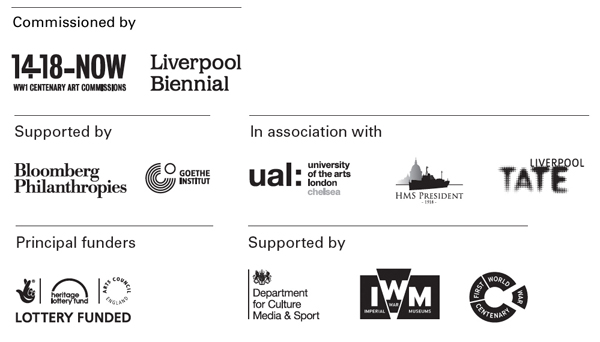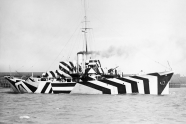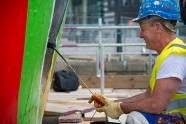Tobias Rehberger, Dazzle Ship London, 2014. Photo: Chris Wainwright
Leading German artist, Tobias Rehberger, has transformed the HMS President (1918) by covering it entirely in ‘dazzle camouflage’ designs as part of 14-18 NOW, the official cultural programme to commemorate the centenary of the First World War. The ship was unveiled on 14 July 2014 and is moored along the Victoria Embankment, between Temple and Blackfriars Bridge in London.
Dazzle Ship London complements Carlos Cruz-Diez’s acclaimed ‘dazzle’ commission for the Edmund Gardner in Liverpool, co-commissioned by 14-18 NOW, Liverpool Biennial and Tate Liverpool in association with Merseyside Maritime Museum.
‘Dazzle camouflage’, also known as ‘dazzle painting’ was used extensively during the First World War as a means of camouflaging a ship, making it difficult for the enemy to target it accurately. As one of the last three surviving warships of the Royal Navy built during the First World War, the HMS President (1918), the first type of warship built specifically for anti-submarine warfare, was originally ‘dazzled’ in this way.
The theory of dazzle painting was first introduced in 1914 by the scientist John Graham Kerr to then First Lord of the Admiralty, Winston Churchill, with the intention of adopting disruptive camouflage which was initially called ‘parti-colouring’. The idea was not to ‘hide’ the ships, but to paint them in such a way that their appearance was optically distorted, so that it was difficult for a submarine to calculate the course the ship was travelling on, and to know from what angle to attack. The ‘dazzle’ effect was achieved by painting the ship in contrasting stripes and curves that broke up its shape and outline.
In 1917, following heavy losses of merchant ships to German submarines, the demand for this camouflage increased. The marine painter, Norman Wilkinson, a future President of the Royal Institute of Painters in Watercolours, promoted the spectacular system of stripes and disrupted lines, characterised by garish colours and sharp interlocking shapes, to which he coined the term ‘dazzle painting’ and was credited with its invention. The strong style unsurprisingly attracted artists’ attention with Picasso claiming it was invented by the Cubists and Vorticist artist Edward Wadsworth, painting a series on the subject after he supervised the application of ‘dazzle’ patterning to over 2,000 ships.
The ‘dazzle’ technique has been a recurring theme in Tobias Rehberger’s work. In 2009 he was awarded the Golden Lion Award at the 53rd International Venice Biennale for a café he created that was based entirely on the principles of dazzle pattern. He was born in 1966 in Esslingen, Germany. From 1987 to 1993 he studied under Thomas Bayrle and Martin Kippenberger at Frankfurt’s renowned Städelschule where he has been Professor of Sculpture since 2001 and until recently also Deputy Rector of the Fine Arts Academy. He has exhibited extensively internationally including shows in New York, Tokyo, London, Paris, Milan, Rome, Brussels, Berlin, and Antwerp and his work is included in many important international collections.
Co-commissioned by 14-18 NOW with Chelsea College of Art and Design and Liverpool Biennial in association with HMS President and Tate Liverpool. Supported by the National Lottery through Arts Council England and the Heritage Lottery Fund and the Goethe-Institut London.

Victoria Embankment
London
Liverpool Biennial
55 New Bird Street
Liverpool L1 0BW
- T +44 (0)151 709 7444
- info@biennial.com
Liverpool Biennial is funded by
Founding Supporter
James Moores




